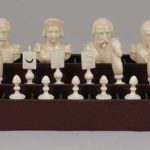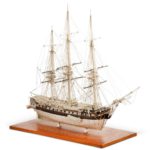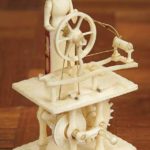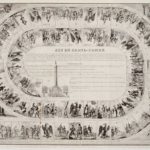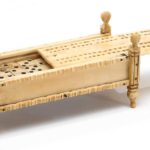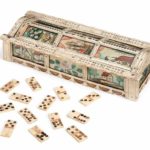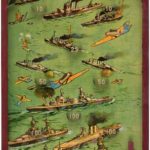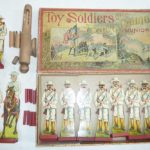It is thought that many Napoleonic games were made by prisoners of war. Many of these show excellent workmanship and are often worked in ivory or bone. Other games with a Napoleonic interest can consist of board games to commemorate the wars such as the “Jeu de Grand-Homme” board game shown below.
Below are some examples and price guides of Napoleonic games including a bone war ship model and a prisoner of war domino set with watercolor panels.
Chessmen (72) with box-board ca. 1855 François Gilot
This set, which according to the card acquired with it, was made for Napoleon III, is for the game of Oriental War. Played on a board of 117 squares (nine by thirteen), it has twenty-seven white pieces and thirty-six red pieces. Each side has nine principal figures and nine knights, and there are nine pawns and eighteen red pawns. The nine principal pieces of each side include five historical figures. The white side, the coalition against Russia, has Napoleon III, the Sultan Abdul Mejid of Turkey, Queen Victoria, Marshal Pelissier of France, and General Alfonso La Marmora of Sardinia; the other principal pieces are the standards of France, Turkey, and Great Britain, and a tower representing Paris. On the Russian side are the Emperor Alexander II, the Empress Alexandra Feodorovna, Prince Michael Gorchakov, Grand Duke Constantine, and Prince Paskievitch (Russian commanders); also, three Russian standards and tower representing St. Petersburg.
Reference: The Metropolitan Museum of Art
NAPOLEONIC PRISONER-OF-WAR BONE SHIP MODEL, Circa 1810 depicting a three-masted ship of twenty-four guns, fully rigged and detailed with horn banding; set in a glass and wood case Height: 11 3/4 inches Length: 13 inches
Sold for 13,750 USD at Sotheby’s in 2019
EARLY 19TH CENTURY CARVED MECHANICAL MINIATURE BONNETED LADY AT HER SPINNING WHEEL
4″ (10 cm.) The intricately-carved miniature bone toy depicts a woman in long Empire era gown and wide-brimmed bonnet seated behind her spinning wheel which is fitted with elaborate working gears and wheels. When the handle at the front is turned, the woman alternately moves her arms and the spinning wheel turns. Excellent condition. Early 1800s, scholars dispute whether these rare and intricate miniatures were created in the French seaside town of Dieppe for several centuries, or by British prisoners of war during the Napoleonic Wars; it is, regardless, an exceptional miniature mechanical gem of superb carving and ingenuity.
Sold for $850 at Theriault’s
Jeu du Grand-Homme Board Game ca. 1835 (published)
Games relating to history and geography were popular throughout Europe and Britain. This game, the name of which translates to ‘Game of a Great Man’, celebrates the important events in the life of Napoleon I. There are 63 playing spaces and the game would have been played very much the same as the ‘Game of Goose’. Instead of various spaces throughout the game having a picture of a goose, they have an eagle.
Reference: © Victoria and Albert MuseumA NAPOLEONIC PRISONER OF WAR GAME CASKET LATE 18TH OR EARLY 19TH CENTURY with a carved and decorated sliding lid with cribbage board, standing on four raised legs with ball tops. Includes dominoes and dice. 2-1/2 x 5-1/2 x 2-1/4 in. (6.5 x 14 x 5.5 cm.)
Sold for US$ 488 (£ 355) inc. premium at Bonham’s in 2011
A NAPOLEONIC PRISONER-OF-WAR BONE DOMINO BOX EARLY 19TH CENTURY With arched top and with fretwork decoration and with watercolour panels, the pine interior with fifty five bone dominoes 9¼ in. (23½ cm.) long
Sold for GBP 1,000 at Christie’s in 2013

